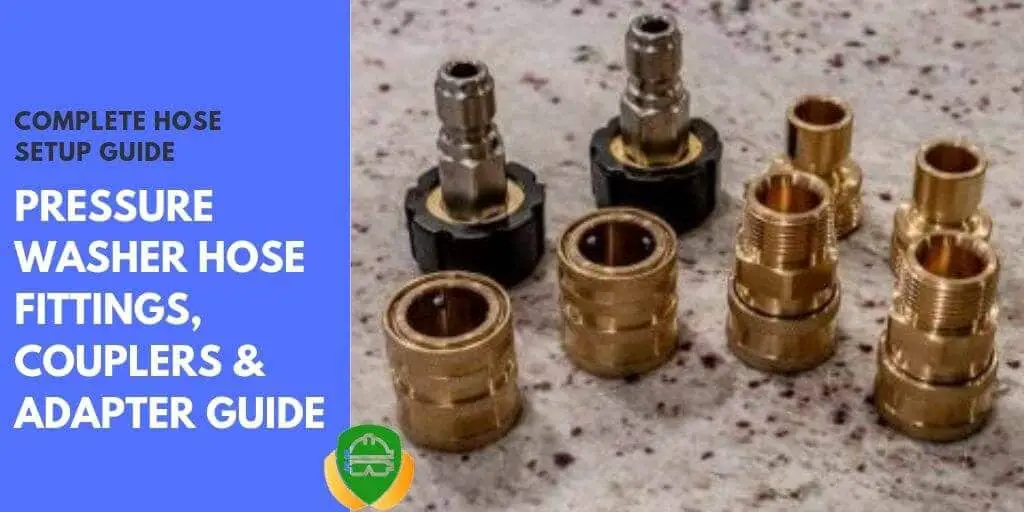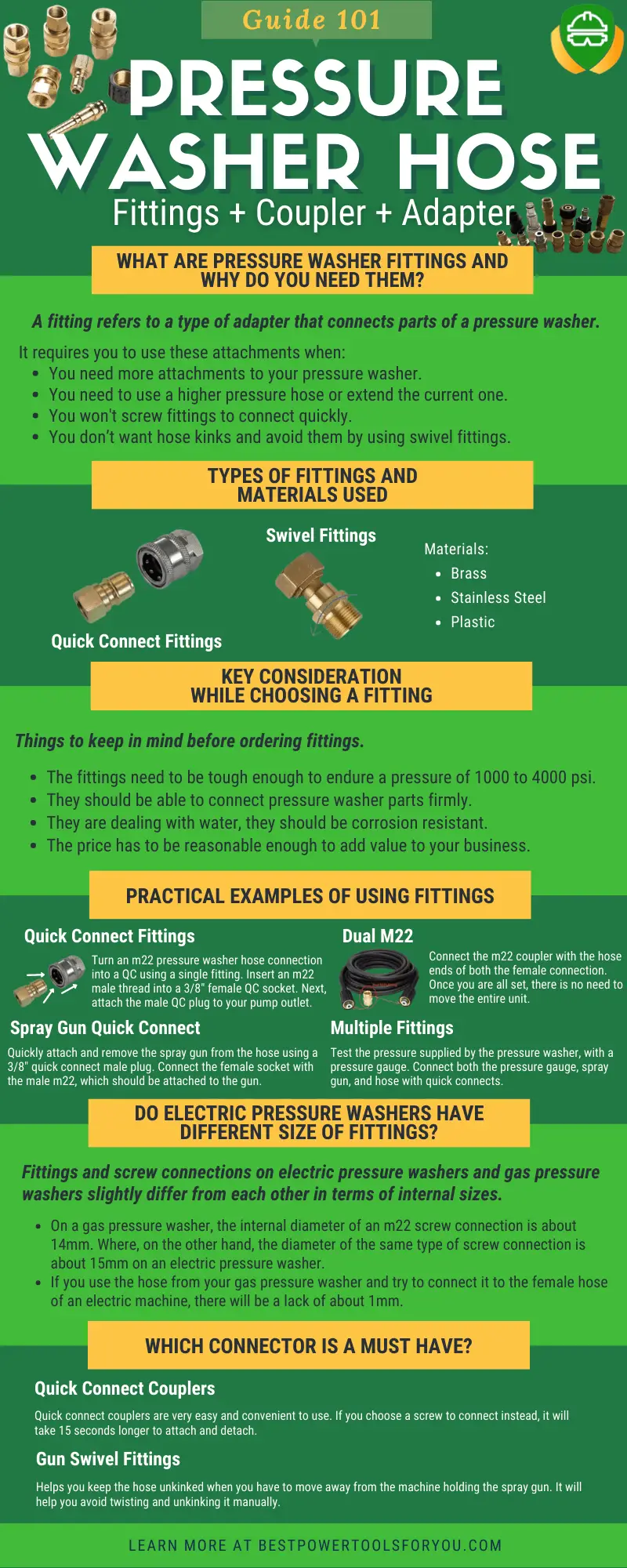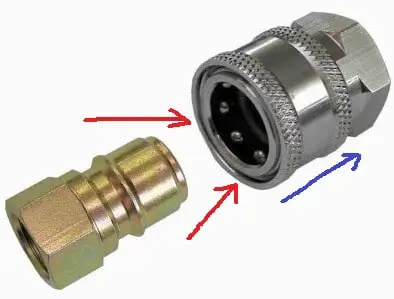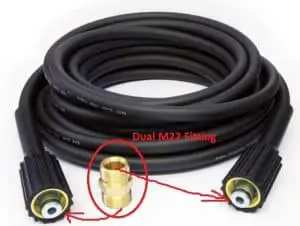Using a pressure washer makes cleaning more effective.

It’s highly recommended to use a pressure washer with appropriate fittings, swivel fittings, adapters, etc. to enhance the cleaning experience. These connectors and adapters allow the users to add more additional parts and accessories as well.
But the issue is, there are plenty of these fittings and adapters to choose from and this is where most of the beginners get confused. Similarly, some people know which one they need, but they are confused regarding the sizes.
[amazon box=”B094WX71DT”]In this article, you are going to learn pretty much everything about pressure washer hose fittings, connectors, adapter, and couplers. Also, you will know which one will suit your cleaning unit the most.
What are Pressure Washer Fittings and Why Do You Need That?

A fitting refers to a type of adapter that connects parts of a pressure washer. You need to fit it between the pressure hose and trigger gun. Similarly, it connects the pressure hose with the pump as well.
Although most of the pressure hose packages include fittings, adapters, and couplers, and you don’t need them always. But there are some situations that require you to use these attachments.
When
- You need to add more attachments to your pressure washer, for example, foamer, surface cleaner, pressure gauge, etc.
- The situation demands you to use higher pressure hose or extend the current one you have.
- You want screw fittings to connect quickly.
- You don’t want hose kinks and avoid them by using swivel fittings.
Types of Fittings
Fittings make your pressure washing work easier. Even though there are plenty of them, they are of a few types.
- Quick Connect Fittings
This type of fittings is used to quickly connect or release the screw connections. If you use a quick-connect fitting, you will find removing the hose or spray gun or pump a lot easier and faster.

Among the quick connect fittings, there are male and female fittings. Female ones come with an O-ring that prevents leakage. Male fittings, on the other hand, go inside of the female ones.
Most pressure washer hose comes with QC fittings of both the types.
- Swivel Fittings
When you walk while holding the pressure washer hose, the wire kinks and you have to manually unkink it every time which is quite disturbing. The swivel doesn’t let the hose kink even when you walk further away from the machine.

The hose cannot unkink itself as it doesn’t spin by its own. But when you connect a swivel to the hose, the swivel allows the hose to spin. You don’t need to twist the gun or extend wand; the swivel will ensure the hose is unkinked all the way.
So, if you need to walk away from the pressure washer machine to clean, this is something you must have. It will both save your time and get you rid of unwanted disturbance.
Materials Used in Fittings
Not all the fittings are equally durable. There are 3 types of materials that are most commonly used for making fittings.
- Brass
Brass is the most widely used material in fittings. These fittings are made of zinc and copper alloy. The alloy is low melting and easy to machine and cast.
This material is corrosion-resistant and durable. Brass fittings are cheaper than stainless steel but more expensive than the plastic ones.
- Stainless Steel
Stainless steel fittings are coated with chromium. It’s rust and corrosion-resistant as well. These fittings are durable and expensive as well.
- Plastic
Plastic fittings are not as durable as brass and stainless steel ones. They are ideal for light electric pressure washers.
Compared to the other two, plastic fittings are cheaper and lightweight. But highly prone to damage or crack.
Rubber O-rings
You cannot categorize the rubber O-ring to any pressure washer hose connector types that are mentioned above. However, know that these rings are for preventing leaks of female fittings. The male quick-connects fits inside the female socket and the ring seals the leak.
Key Consideration While Choosing a Fitting
To make your purchase worth, be sure to keep these things in mind before ordering fittings.
- The fittings need to be tough enough to endure 1000 to 4000 psi over.
- It should be able to connect pressure washer parts firmly.
- No matter how hard you tug, it should have robust construction to be able to bear it.
- There should be no compromise regarding corrosion resistance as it will deal with water.
- For business purpose, the price has to be reasonable enough to add value to your business.
Pressure Washer Quick Connect Sizes
This is the part where most people end up taking the wrong decision. People mostly get confused about the size of fittings; whether they should consider the inside or outside diameter and how precise the fitting needs to be?
You will find fittings that are of 3/8”, 22mm, 14mm from the inside. There are both British and American pipe thread standards to make you even more confused. No matter which one you are confused with, this section will make things clear to you.
To figure out the actual size, you will need calipers. Taking a measuring tape will not do any help as 1mm of difference matters as well. But before discussing the measurements, let’s get familiar with the British and American Standard pipe thread.
NPT (National Pipe Thread) is known U.S. standard for screw threads.
BSP (British Standard Pipe) is known as British standard for screw threads.
The reason why you need to consider both NPT and BSP is that you will come across fittings having the diameters either in NPT or BSP. A fitting with 3/8” NPT size will not be the same in size of another 3/8” fitting of BSP size.
As a result, you will not be able to put a male BSP fitting into a female NPT connection correctly. Got it?
- M22 Adapter Size
Furthermore, you need to consider both the internal and external diameters of the connectors. Take m22 adapter for example, which is very common on hoses, spray guns, and pumps. It has a diameter of 22m from the outside and 14mm from the inside. Also, a female m22 has an inner plug about 14mm.
Furthermore, the thread has 14mm internal diameter on a gas pressure washer, but on the other hand, the same adapter has 15mm diameter on an electric pressure washer.
- BSP Thread Size
Whenever you see the fitting of 3/8”, know that the numbers don’t tell you about the size; rather, it’s the name of the fitting which may sound weird. A 3/8” fitting has a diameter of around 16.66mm which means it’s actually of 2/3-inch.
- QC Plug and Socket Size
All the quick connects are of 3/8”, so here, you don’t need a caliper to measure the sizes of quick connects.
Practical Examples of Using Fittings
Now let’s demonstrate on some of the uses of fittings on a pressure washer hose connector.
- Pressure Washer Quick Connect Fittings

You can turn an m22 pressure washer hose connection into a QC using a single fitting. Insert an m22 male thread into a 3/8″ female QC socket. After that, attach the male QC plug to your pump outlet. In this way, you will be able to connect a high-pressure hose with a pump very easily.
- Dual M22
If you need to extend the length of your pressure hose, then consider getting an m22 pressure washer hose coupler.  Simply connect the m22 coupler with the hose ends of both the female connection. Once you are all set, there is no need to move the entire unit.
Simply connect the m22 coupler with the hose ends of both the female connection. Once you are all set, there is no need to move the entire unit.
- Spray Gun Quick Connect
Previously in example 1, I explained how you can turn an m22 hose connection into a quick connect and attach it to a pump. Now, this one is the same process, but here you will deal with spray gun instead of the pump hose.
You will be able to quickly attach and remove the spray gun from the hose using a 3/8″ quick connect male plug.
The female socket needs to connect with the male m22, which should be attached to the gun. On the other hand, the QC male plug will go inside the female socket of 3/8″ QC. And finally, the m22 male connector will connect to the m22 female which is attached to the hose.
- Multiple Fittings
If you need to test the pressure supplied by the pressure washer, then you will need a pressure gauge. So, here you have to connect both the pressure gauge, spray gun, and hose with quick connects.
Note that, pressure gauge comes with quick connect fittings; therefore, you require appropriate adapters to make it connect with the spray gun and hose.
At first, connect the m22 male with the female one. Then 3/8” quick connect needs to connect with the 3/8” QC male plug. Connect the pressure gauge with a 3/8” QC male plug at the top, and 3/8” QC female at the bottom.
Now, connect the QC male plug to 3/8” QC female connection which is connected with the pressure gauge, and finally, m22 female hose connection to the m22 male.
Do Electric Pressure Washers have Different Size of Fittings?
Fittings and screw connections on electric pressure washers and gas pressure washers aren’t the same. They slightly differ from each other in terms of internal sizes.
On a gas pressure washer, the internal diameter of an m22 screw connection is about 14mm. Where, on the other hand, the diameter of the same type of screw connection is about 15mm on an electric pressure washer.
So, if you use the hose from your gas pressure washer and try to connect it to the female hose of an electric machine, there will be a lack of about 1mm. Because you are trying to fit a 14mm hose from the gas machine to a 15mm female hose of an electric machine.
Which Connector is a Must Having one?
In my opinion, there are two fittings that every pressure washer machine owner must-have.
- Quick Connect Couplers
When it comes to attach and release the pressure hose from the pump or spray gun, nothing can beat quick connects. These are very easy and convenient to use.
If you choose a screw to connect instead, it will take 15 seconds longer to attach and detach. Furthermore, you cannot deal with such screw connects with one hand. So, without a doubt, a quick-connect coupler can make your pressure washing experience even better.
- Gun Swivel Fittings
No one would disagree with the fact that working with a pressure washer becomes annoying when you have to move away from the machine holding the spray gun, and it kinks. The situation would require you to twist and unkink it manually.
If you have a gun swivel fitting attached to the spray gun, it will unkink by its own and make things less hassle while saving your precious time.
Are pressure washer hoses Universal?
Each part of a pressure washer is designed according to whether it is run by an electric engine or a gas motor. This means that nozzles, guns, and even hoses are not universal for pressure washers.
Some hoses are better designed for higher pressures than others, which can be determined by the motor or engine. The higher the quality of the material, the more expensive the hose will be.
Pressure washer hoses will also vary in length and how it connects to the water source and the gun. Before buying a hose, check whether it has a male and/or female connector. This is another reason why pressure washer hoses aren’t universal because they won’t all connect the same way.
Gas pressure washers are more likely to be universal electric pressure washers, which can often be brand-specific and require parts specifically from the manufacturer. This can make a difference when looking to buy a pressure washer.
Can I turn my hose into a pressure washer?
Pressure washers can be expensive, heavy, and non-essential items. Fortunately, it is possible to turn a hose into a pressure washer!
You will need a functioning hose with a water jet that comes with a variety of functions. These functions can range from sprinkling (ideal for watering flowers) to powerful. This will be a thinner line of water that comes out at a strong rate.
Our top tip is to keep the hose as short as possible, as a longer hose requires more distance for the water to go – which means there will be less pressure.
Before trying to do this, make sure that your hose is in good shape before turning the water to the highest setting through a faucet. If there are kinks and potential areas for leakage, it won’t be able to handle the pressure of the water.
Whilst a regular hose will not be as powerful or as effective as a pressure washer, this is a useful hack for loose stains.
What is the best pressure washer hose to buy?
The best pressure washer hose is the YAMATIC 50ft High-Pressure Washer Hose. Whilst pressure washer hoses can only be the “best” depending on whether it is connected to an electric engine or gas motor, this hose can suit a variety of brands.
It is most suitable for 3200 PSI pressure washers – this figure indicates how much energy is used to force the water to the object it is cleaning.
This hose is made of layers of ABS plastic and brass to prevent leaking at the connection to the water source. The plastic is sourced from recycled material, making it environmentally friendly. What’s more, this plastic prevents kinks and bends – therefore this is a durable and long-lasting hose that is resistant to wear and tear.
It can also stretch up to 50ft in length, which is ideal for professional use, long yards, and driveways. This hose is best suited for gas pressure washers, but can also be used for some electric washers.
What is the best garden hose to use with a pressure washer?
We recommend the Generac 6621 Pressure Washer Hose. Suitable to work like a garden hose and a pressure washer hose, this nylon hose is as durable as it is flexible. This is ideal for a pressure washer hose, as it means the user has more freedom of movement when cleaning.
This hose can work with most pressure washer brands with m22 female connections of up to 3200 PSI. This is the most ideal PSI figure for a pressure washer hose, as it means it can handle a large power and volume of water as it comes from the engine or motor.
At 30 feet long, it can be used in a warehouse, driveway, yard, or to clean a house or car. It is also only 2.2 pounds in weight, so it can be transported around easily.
It’s important to remember that garden hoses aren’t generally designed to handle hot or warm water, and unfortunately, this is the same for this hose. Keep this in mind, as pressure washers generate warm water!
How do I know what size my pressure washer hose is?
Pressure washer hoses are designed for ultimate durability, but they will begin to tire after several years of use. It’s important to know the size of the hose when looking for a replacement. You might also need the size for accessories such as a surface cleaner or foamer.
The manufacturer will state the length of each pressure washer hose, which can range anywhere from 20 to over 50 feet long.
In terms of diameter, you can use the same diameter as your regular garden hose or check with the manufacturer (or the user manual if you still have it!). The most common diameter is 1/4-inch. The least common diameters are 3/8-inch and 5/16-inch hoses.
The best way to find the best size pressure hose is to take your original hose to a professional or to contact the manufacturer if you are unsure. Fortunately, fittings are generally inexpensive.
Does hose diameter affect water pressure?
Yes! In the simplest of explanations, the larger the diameter, the higher the water pressure it can create.
Think of it like a faucet: when you turn it to the right, the water comes out extremely fast and at high pressure. When you turn it slightly, the water is less powerful.
The same goes for the hose diameter. Most regular hoses have a diameter of 1/4-inch or 1/2-inch, which will provide more water pressure. Anything smaller will still offer high-pressure water depending on the pressure washer engine or motor, but the pressure will be weaker.
If you’re experiencing problems with your hose, whether in garden use or for a pressure washer, there’s a chance that this is due to the diameter. Other problems could be down to leaks, low water pressure from the water supply, kinks or bends, or if the hose simply isn’t connected properly.
The hose length will also affect the water pressure. The longer the hose, the lower the flow rate will be.
[amazon box=”B094WX71DT”]Final Words
The examples that are mentioned above are the most practiced way of using the machine effectively. Dealing with the connectors, couplers, fittings, and swivels seem complicated at first. But as soon as you know about their types and how they work, you will be able to handle the pressure washer machine like a pro.
Pressure washer fittings are an excellent choice for reducing the hassle of the work. Wisely choose which type you need and it’s material. Also, consider the sizes according to both the British and U.S. standard as well to prevent leakage and breaking connectors.
